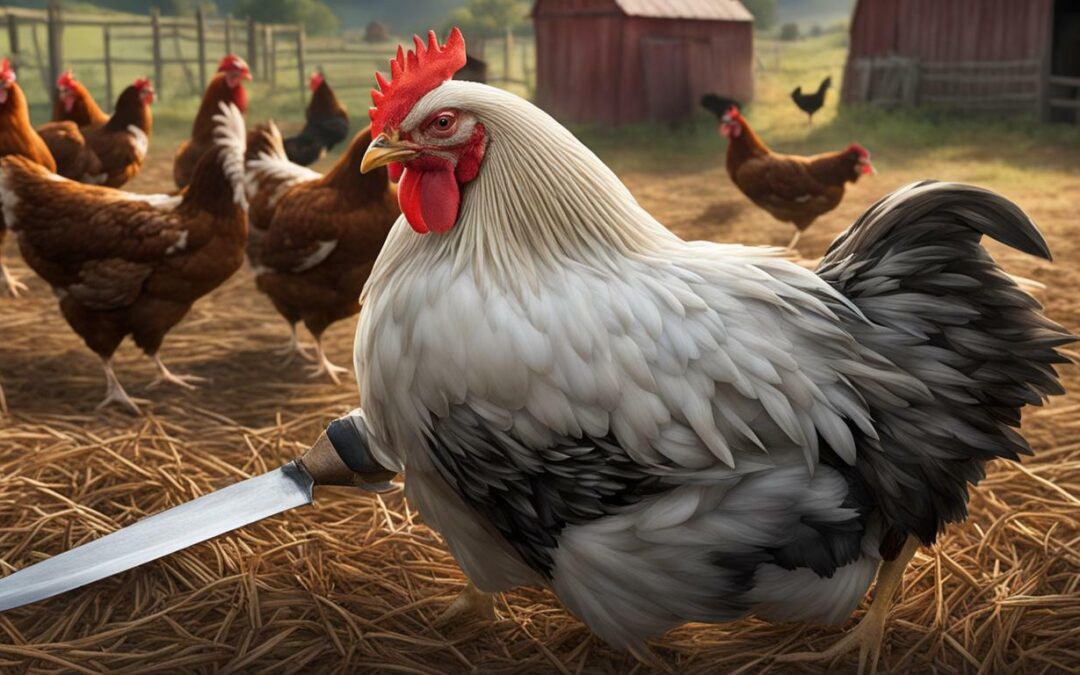Concerned about How to Cull a Chicken? Well, Culling a chicken is a necessary task for chicken owners, ensuring the welfare of the flock and maintaining responsible farming practices. There are various methods of culling chickens, but it is crucial to ensure that it is done in a humane and efficient manner.
One method is cervical dislocation, where the chicken’s head is quickly and firmly pulled backward to break its neck. This should be done swiftly and confidently to ensure a clean break. Another method is decapitation, where a sharp axe, hatchet, or butcher’s knife is used to swiftly remove the chicken’s head. It is important to ensure a clean cut and to stun the chicken beforehand to minimize potential pain. Lastly, bleeding out the chicken using a poultry cone and cutting the carotid artery can also be a humane method if done correctly. It is essential to locate the artery, make a clean cut, and ensure that the chicken is unconscious to avoid unnecessary suffering.
It is important to approach the task with respect and to do what is best for the welfare of the chicken.
Key Takeaways:
- To Cull a Chicken is a necessary task for chicken owners
- Various methods of culling chickens include cervical dislocation, decapitation, and bleeding out
- Cervical dislocation involves swiftly breaking the chicken’s neck
- Decapitation requires a clean cut and stunning the chicken beforehand
- Bleeding out must be done with a poultry cone, a clean cut, and ensuring the chicken is unconscious
Different Methods of Culling
There are different methods available for culling a chicken, each with its own considerations. It is important to approach this task with care and prioritize the welfare of the chicken. Here, we will explore three common methods: cervical dislocation, decapitation, and bleeding out.
Cervical Dislocation
Cervical dislocation involves swiftly and firmly pulling the chicken’s head backward to break its neck. This method should be performed with confidence and speed to ensure a quick and clean break. It is considered a humane way to cull a chicken, but it requires practice and skill to execute correctly. Always remember to handle the chicken with care and minimize any potential distress.
Decapitation
The decapitation method involves using a sharp axe, hatchet, or butcher’s knife to swiftly remove the chicken’s head. It is crucial to ensure a clean cut to minimize pain for the chicken. Before performing decapitation, it is recommended to stun the chicken beforehand to render it unconscious and lessen any potential distress. Proper technique and a steady hand are essential to execute this method effectively.
Bleeding Out
Bleeding out is another method used to cull chickens, where the chicken is placed upside down in a poultry cone and the carotid artery is cut. This method can be humane if done correctly. It is important to locate the artery and make a clean cut to ensure a quick and efficient bleed-out process. Always ensure that the chicken is unconscious before proceeding to minimize any suffering.
Remember, regardless of the method chosen, responsible farming practices and humane treatment should always be maintained when culling chickens. Approach this task with respect and prioritize the welfare of the chicken at all times.
Cervical Dislocation Method
Cervical dislocation is a method commonly used to cull a chicken and can be carried out in a humane and efficient manner. This method involves the quick and firm pulling backward of the chicken’s head to break its neck. It is important to approach this task with confidence and ensure a swift, clean break to minimize pain and suffering.
To perform cervical dislocation, follow these steps:
- Grasp the chicken’s head firmly but gently with one hand, placing your thumb on one side of the neck and your fingers on the other.
- Hold the chicken’s body securely with your other hand, ensuring it remains calm and still.
- With a swift and decisive motion, pull the chicken’s head backward, away from its body. This should result in a clean break of the neck, causing instant unconsciousness and eventual death.
It is crucial to note that proper technique and precision are essential to carry out cervical dislocation effectively. This method should only be performed by individuals who are trained and confident in executing it safely and humanely.
Precautions
When performing cervical dislocation, it is important to take the following precautions:
- Ensure that the chicken is calm and properly restrained before initiating the process to minimize stress and avoid injury to yourself or the bird.
- Check for any signs of consciousness or movement after the procedure. If the chicken is not unconscious, repeat the dislocation process or consider an alternative method.
- Dispose of the chicken’s body appropriately and responsibly, following proper biosecurity measures and local regulations.
Cervical dislocation is one of the methods available for culling chickens, and when performed correctly, it can be a humane and efficient way to end the life of a chicken. However, it is essential to consider other methods, such as decapitation or bleeding out, if the cervical dislocation is not suitable or not preferred for any reason.
Decapitation Method
Decapitation is another method used to cull a chicken and requires precise execution to ensure a clean cut and minimize any potential pain. To perform decapitation, you will need a sharp axe, hatchet, or butcher’s knife. Before starting, it is crucial to stun the chicken to render it unconscious and reduce suffering.
Steps for Decapitation:
- Secure the chicken: Hold the chicken firmly by its legs or wings to ensure control during the process.
- Position the chicken: Place the chicken’s neck on a secure surface, such as a chopping block, with its head extending slightly beyond the edge.
- Swift motion: With a single, swift motion, bring down the sharp tool of choice with precision to sever the chicken’s head from its body. Aim for a clean cut to minimize any pain.
- Discard the head: After decapitation, safely dispose of the chicken’s head away from the chicken’s view to prevent distress.
- Ensure consciousness is lost: Ensure the chicken is unconscious by observing the absence of any movement or signs of life after decapitation.
- Minimize bleeding: To minimize bleeding, elevate the chicken’s body vertically for a brief period.
Please note that it is crucial to approach this method with respect for the animal’s welfare. Swift and accurate execution is vital to minimize suffering. Remember to follow any local regulations or guidelines regarding animal welfare and culling.
By following proper and humane techniques, such as the decapitation method, chicken owners can manage their flock responsibly and ensure the welfare of their animals.
Bleeding Out Method
Bleeding out a chicken in a poultry cone can be a humane method of culling when done correctly, ensuring the chicken is unconscious and the artery is cleanly cut. This method is often preferred by farmers who prioritize minimizing pain and discomfort for the chicken during the culling process. Here is a step-by-step guide on how to bleed out a chicken in a humane manner:
- Prepare a poultry cone: Start by securing a sturdy poultry cone in a stable position, ensuring that it is at a comfortable height for you to work with. The cone will help restrain the chicken during the process.
- Render the chicken unconscious: Prior to bleeding out the chicken, it is crucial to ensure that it is unconscious to prevent unnecessary suffering. This can be done by stunning the chicken using a blow to the head or by using a specialized stunning device.
- Position the chicken in the cone: Place the chicken’s head first into the poultry cone, with its body extending downward. Make sure the chicken’s wings are secured against its body to prevent flapping during the bleeding process.
- Cut the artery: Locate the carotid artery on the side of the chicken’s neck. Using a sharp knife or scissors, make a clean and swift incision in the artery. The cone will collect the blood, making the process more controlled and sanitary.
- Allow the chicken to bleed out: Once the artery is cut, allow the chicken to bleed out completely. This usually takes a few minutes and ensures a swift and humane death for the chicken.
Remember, it is essential to approach culling with respect and prioritize the welfare of the chicken. By following proper techniques and ensuring a quick and humane process, you can fulfill the necessary task of culling a chicken responsibly.
Conclusion
To cull a chicken is a necessary part of maintaining the welfare of a flock and practicing responsible farming, and it is crucial to approach the task with respect and prioritize the well-being of the chickens. When it comes to culling a chicken, there are different methods that can be used, each with its own considerations to ensure a humane and efficient process.
One method is cervical dislocation, where the chicken’s head is quickly and firmly pulled backward to break its neck. This should be done swiftly and confidently to ensure a clean break and minimize any potential pain for the chicken. It is important to perform cervical dislocation in a manner that is quick and humane.
Decapitation is another method of culling chickens. It involves using a sharp axe, hatchet, or butcher’s knife to swiftly remove the chicken’s head. Achieving a clean cut is essential for minimizing pain and discomfort for the chicken. Prior to decapitation, it is important to stun the chicken to ensure it is unconscious.
Finally, bleeding out a chicken can be done using a poultry cone and cutting the carotid artery. This method can be humane if performed correctly. It is crucial to locate the artery, make a clean cut, and ensure that the chicken is unconscious to prevent unnecessary suffering.
Approaching the task of culling a chick with respect and prioritizing the welfare of the chicken is essential. Responsible farming practices involve making informed decisions and taking appropriate action when necessary. Culling may be a difficult task, but it is a necessary part of maintaining a healthy and thriving flock.
FAQ
What does culling a chicken mean?
Culling a chicken refers to the process of humanely and responsibly removing a chicken from a flock, typically due to reasons such as illness, injury, or aggressive behavior.
Why is it important to cull a chicken?
Culling a chicken is important for maintaining the overall health and well-being of a flock. It helps prevent the spread of diseases, reduces the risk of injuries, and ensures a conducive environment for the remaining chickens.
What are some different methods of culling chickens?
There are several methods of culling chickens, including cervical dislocation, decapitation, and bleeding out.
How is cervical dislocation performed?
Cervical dislocation involves quickly and firmly pulling the chicken’s head backward to break its neck. This should be done swiftly and confidently to ensure a clean break.
How is decapitation performed?
Decapitation is the use of a sharp axe, hatchet, or butcher’s knife to swiftly remove the chicken’s head. It is important to ensure a clean cut and stun the chicken beforehand to minimize potential pain.
What is the bleeding out method?
Bleeding out involves using a poultry cone and cutting the carotid artery to allow the chicken to bleed out. It is important to locate the artery, make a clean cut, and ensure the chicken is unconscious to avoid unnecessary suffering.
How should I approach the task of culling a chicken?
Culling a chicken should be approached with respect and the welfare of the chicken in mind. It is essential to choose a humane method and perform it swiftly and efficiently to minimize any potential pain or suffering.

